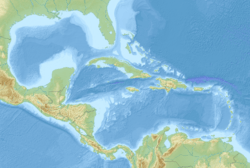2006 Gulf of Mexico earthquake facts for kids
| UTC time | 2006-09-10 14:56:08 |
|---|---|
| ISC event | 8659780 |
| USGS-ANSS | ComCat |
| Local date | September 10, 2006 |
| Local time | 10:56 EDT |
| Duration | ~ 20 seconds |
| Magnitude | 5.8 Mw |
| Depth | 14 km (9 mi) |
| Epicenter | 26°15′N 86°38′W / 26.25°N 86.63°W |
| Type | Reverse |
| Areas affected | Southeastern United States |
| Max. intensity | IV (Light) – Florida |
| Tsunami | No |
The 2006 Gulf of Mexico earthquake happened in the eastern Gulf of Mexico on September 10, 2006. It occurred at 10:56 AM Eastern Daylight Time. This earthquake was quite strong, measuring 5.8 on the Moment magnitude scale.
Its center, called the epicenter, was about 250 miles (400 km) west-southwest of Anna Maria, Florida. People felt the shaking across much of the Gulf Coast of the United States. This was the second earthquake of magnitude 5 or more in the Gulf of Mexico that year. In Florida, the shaking was felt as "Light," and in parts of Georgia, it was "Weak."
Contents
What Caused the 2006 Gulf Quake?
This earthquake was the strongest in the Gulf of Mexico in 33 years. It was an intraplate earthquake. This means it happened far away from the edges of tectonic plates. Most earthquakes occur where these large plates meet and grind against each other.
Earthquakes are not very common in the Southeastern United States. However, some strong ones have happened there before. For example, in 1879, an earthquake near St. Augustine, Florida caused plaster to crack. Dishes also fell off shelves. The 1886 Charleston earthquake in South Carolina was much more serious. It caused a lot of damage and led to the deaths of sixty people.
Why Earthquakes Happen in the Gulf
The 2006 earthquake happened near the Cuba Fracture Zone. This area is far from the edge of the North American Plate. Scientists believe the force for this quake came from the Mid-Atlantic Ridge. This is where new seafloor is created, pushing the North American Plate.
Another earthquake, measuring 5.2, happened in February 2006. It might have been caused by the same fault system. A fault is a crack in the Earth's crust where rocks have moved.
Understanding the Quake's Depth
Scientists use special tools called seismographs to study earthquakes. Because this earthquake was far offshore, it was hard to get a clear picture of it. However, they found it was a "reverse faulting" type of earthquake.
The earthquake's depth was between 14 and 31 kilometers (about 9 to 19 miles). This means it happened deep within the Earth's crust. It was not a shallow quake.
How the Earthquake Was Felt
Thousands of people reported feeling the earthquake to the United States Geological Survey. The shaking lasted for about 20 seconds. Luckily, no one reported any damage from this event.
In parts of Florida, the shaking was strong enough to knock items off shelves. People also saw "seiches" in swimming pools. A seiche is like a sloshing wave in an enclosed body of water. This happened in places like Brooksville, Titusville, and Panama City. In Atlanta, Georgia, the shaking was reported as less strong.


